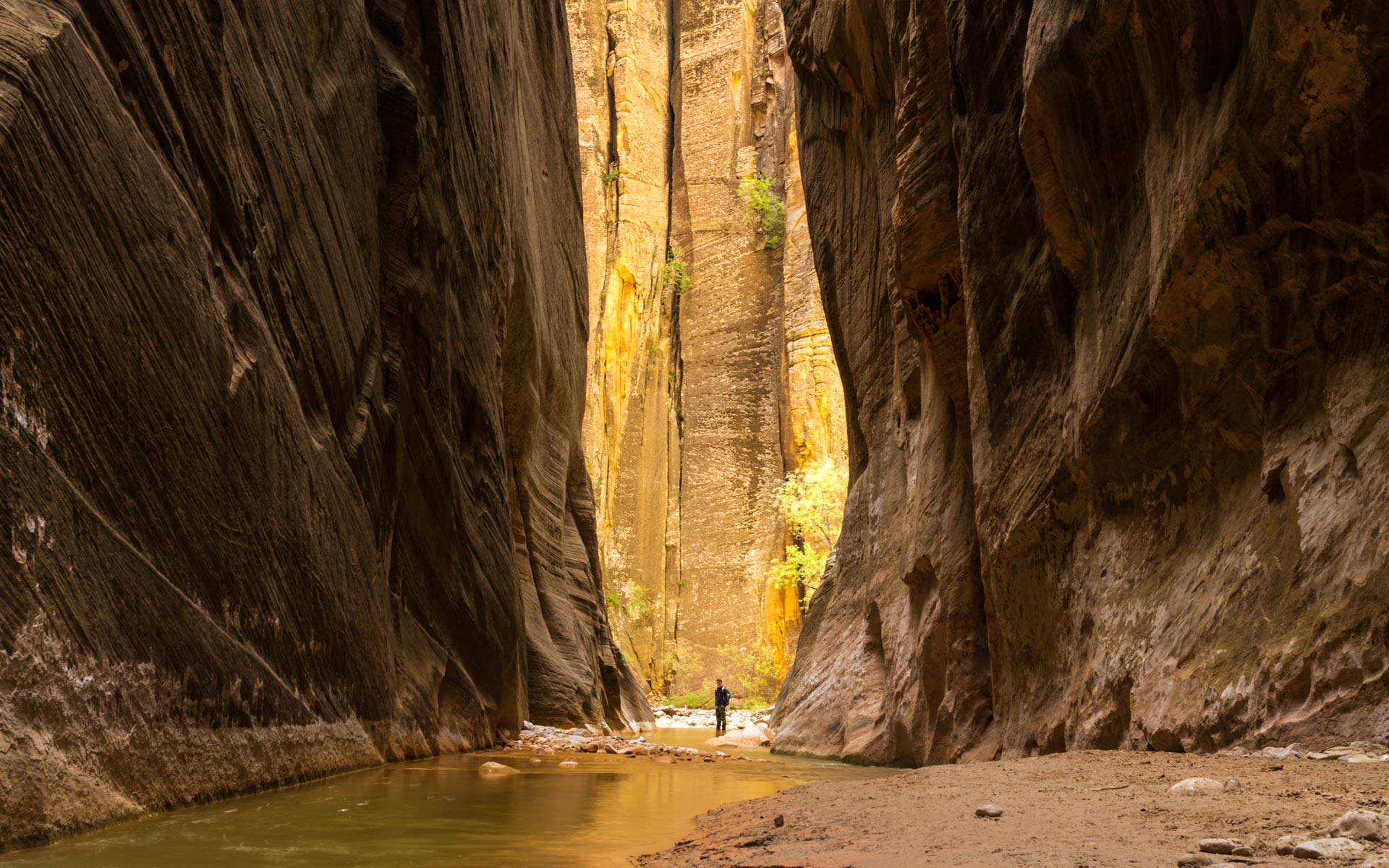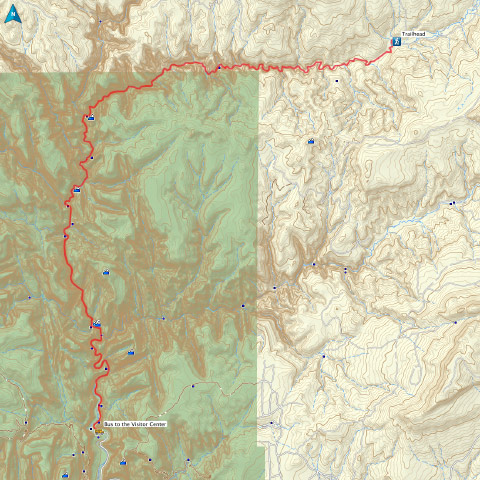
- Destinations
- Utah
- Zion NP
- Virgin Narrows
Hiking and photographing the Virgin Narrows is something unique and your memories will be unforgettable. One of the main reasons for such a statement resides in the fact that you are almost the entire time immersed in the Virgin River – seldom just your feet, most of the time up to your knees and sometimes higher – depending at the time of the year and how much water the river is carrying you might even get to some moments were you need to swim short stretches.
Practical advices:
Much of your preparations depend which season of the year you are choosing to go into the Virgin Narrows and how much in depth you want to explore the it.
Summer is certainly the most popular of all seasons. It makes certain stretches of the Virgin Narrows very populated which might strain your photographic opportunities. You will also run the risk of flash flooding specially during July and August. During these months the Park Service might even close the entrance to the Narrows if there is a forecast for a thunderstorm in the afternoon. Otherwise, you will encounter a sign-post warning of the potential risks of flash floods and rating the danger of the day. The best way to dodge the Narrows packed with people and facing the risk of flash floods is getting there in the early morning and get out around noon. However, this limits your radius to the lower portion of the Narrows, meaning that you first will have to walk upstream until you reach Orderville Canyon and then turn around and walk with the stream. You cannot go beyond this point if you do not have a permit.
Winter and spring are not necessarily advisable seasons to visit the Narrows. Walking in water at freezing temperatures will require very good water-suits and might still not be enough protection against the cold.
Spring is characterized by high and quite fast water flow as it is the melting period. It might even be quite dangerous to adventure into the Narrows under such circumstances!
In my personal opinion the best season to hike in the Narrows is autumn by far. The water levels are relatively low which is favorable for comfortable hike and the water temperature is not too cold. The Narrows are not packed with people and getting a permit is an easy task. On top of all these details you will encounter fall colors which will boost your photographic experience.
The next step after you have decided which season is the right for you is to make your choice in how extensively you want to explore the Narrows. There are several points where you can enter the Narrows. The easiest one is from below – starting at the Gateway to the Narrows and walking upstream as far as Orderville Canyon. The other points of entry for the top to the bottom approach (downstream) are: Chamberlain Ranch, Orderville Canyon, Birch Hollow, Englestead Hollow and Mystery Canyon. The common denominator to all these options are that you need a permit and you will need a shuttle to get to the trailhead.
Regards obtaining a permit and the different kind of permits I advise to check with the National Park Service. The best strategy to ensure that you have a permit is doing this three to four months ahead.
For the hike I recommend you to have some suitable hiking gear: dry suit, neoprene socks, canyoneering shoes and hiking poles. Latter is indispensable as you will be walking more or less the entire day through the riverbed. The hiking poles will help you to probe the riverbed for treacherous rocks or holes and keep your balance if the current is strong.
If you do not have this gear you can rent it at Zion Adventures in Springdale.
Getting into the Virgin Narrows:
Entering the Narrows from the bottom is certainly the easiest option. You do not need a permit and you will not need to pay for a shuttle as you can drive up the Zion Canyon road yourself during late autumn or take the free National Park Service shuttle during summer to get to the trailhead at the Gateway to the Narrows. However, be aware that you can only walk up to Orderville Canyon confluence, after this point you need a permit to continue upstream or turn around and walk back to the parking lot to get to your car or the shuttle.
There are two shuttle bus services. One starts in Springdale and the other at the Zion Canyon Visitor Center. The average wait for a shuttle bus is fifteen minutes or less. The wait is longer in the morning and evening, but shorter during peak hours. The schedule varies throughout the year. Make sure that you know the last bus leaving from the Gateway to the Narrows trailhead so that you do not get stuck there overnight. Check here for an updated shuttle schedule.
To enter the Virgin Narrows from the top you will need a permit and a private shuttle service. Zion Adventures, located in Springdale, takes you to all the above mentioned points of entry.
My point of start was Chamberlain Ranch. This the longest hike down the Virgin Narrows. The general recommendation for this route is to backpack with a night in the Narrows. I did the entire stretch in a single day. The downside in doing it in one day is that it will not give you much time to explore the Narrows photographically very well You need to pace yourself constantly to make sure that you will get the last National Park shuttle bus of the day. This hike is a little bit more than 17 miles long. All the other hikes from the top have a lower mileage.
Make your reservations for the private shuttle online way ahead of your trip. The shuttle meets everybody at the Zion Canyon Visitor Center early morning and takes you up to the trailhead. Leave your car at the Zion Canyon Visitor Center were you will pick it up in the late afternoon after the National Park shuttle bus dropped you of at the Visitor Center.
It might be good a good idea to have some dry and warm clothes waiting for you in your car to get rid of the wet, cold and dirty stuff you used the entire day throughout your hike in the water.
Taking shots:
Before you even start thinking of what photographic gear you need to carry with you, you first need to spend some moments coming up with some plans how to protect the gear from the water which will be surrounding you during the entire hike. There is a fair chance that you might fall into the water while balancing yourself over slippery boulders or stumble on rocks or branches hidden under the water. It happened to me and there is a huge chance that it will happen to you too.
Zion Adventure, the same store were you can get your private shuttle to the top to the bottom trailheads and rent your hike gear also offers airtight plastic bags. Use several small of them for each piece of your photographic gear or take a single large one.
Once everything is in airtight bags the next step is to have these in a backpack. You really need your hands and arms to balance yourself quite often and a bag around your neck or shoulder will not allow this very well.
A tripod, as cumbersome as it might be, will be one of the most valuable assets during this hike. The light in the Narrows is dim and if you want big prints out of this adventure and details in the dark parts of the images you will need to keep the ISO as low as possible. In other words, take the tripod with you!
As for lenses a wide angle and a mid zoom will be just perfect to keep open the creative possibilities in framing the various scenes. A circular polarizing filter might be of some help in certain moments to avoid reflections on the rocks. It also helps you to slow down the shutter even more and achieve silky water movement.
Light bouncing off the walls in the Narrows is at its best in early to mid morning during summertime and around mid day in late autumn.
My personal preference is mid to late autumn as the trees and bushes turn the landscape in a colorful feast ranging from bright yellow to dark red.
Last update: April 1, 2014

